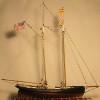-
Posts
74 -
Joined
-
Last visited
Profile Information
-
Gender
Male
-
Location
Beaverton, OR
Recent Profile Visitors
-
datadiscovery started following SteveM
-
 FrankWouts reacted to a post in a topic:
Where to buy wood
FrankWouts reacted to a post in a topic:
Where to buy wood
-
 Warnerade reacted to a post in a topic:
Where to buy wood
Warnerade reacted to a post in a topic:
Where to buy wood
-

Harbor Freight Workbench
SteveM replied to Landlubber Mike's topic in Modeling tools and Workshop Equipment
Couldn't say, but I do have a pair or two of 100lb full extension drawer slides left over from a workbench project. Stop by next time you're in the area and see if I haven't remembered to bring them in with me. -
 SteveM reacted to a post in a topic:
Phantom by MikeB4 - Model Shipways - scale 1:96
SteveM reacted to a post in a topic:
Phantom by MikeB4 - Model Shipways - scale 1:96
-
 SteveM reacted to a post in a topic:
Phantom by MikeB4 - Model Shipways - scale 1:96
SteveM reacted to a post in a topic:
Phantom by MikeB4 - Model Shipways - scale 1:96
-
 SteveM reacted to a post in a topic:
Glue Recommendations
SteveM reacted to a post in a topic:
Glue Recommendations
-
It's just wood, I'm sure you can fix it or patch it up to look correct. The rudder is made up of 3 or 4 pieces of 1/8" square stock glued together. The instruction booklet has a diagram of this if my memory serves me.
- 41 replies
-
- model shipways
- phantom
-
(and 1 more)
Tagged with:
-
The Veritas honing guide doesn't sharpen anything so it isn't necessarily responsible for the lengthy sharpening session. The Mk II guide has a knob that allows you to select between primary and secondary bevels. Once you've got that primary bevel established just sharpen on the secondary bevel for a while till it gets wide and takes longer to sharpen. When that happens got back and sharpen the primary bevel till it meets the cutting edge. I started out with the Veritas Mk II and sandpaper, but I was starting to use up a lot of sandpaper and decided to switch to oil stones and free-hand. What I do now is establish a primary bevel at about 25 degrees on a cheap 6" bench grinder with a 36 grit wheel. Use light pressure, dress the wheel as needed, and dip the chisel in water to keep it cool as needed. Once I've established this primary bevel I don't go back to the grinder for a long time. Next I move on to a medium grit India stone and hone till I feel a slight burr across the entire back of the chisel then I move on to a black Arkansas stone and hone till I've removed all of the scratches from the India stone. Then I take a few swipes on a leather strop charged with green stropping compound and end with a single swipe on the back to remove any burr that might remain. As I'm working I'll occasionally revisit the strop and when it starts to feel dull I drop back to the black Arkansas stone and proceed as described above. To test for sharpness I try to cut across the end grain of a soft wood such as pine. A truly sharp tool will cut through smoothly while a dull one will crush the end grain and tends to slip out of the cut. What I didn't mention yet is that the backs of my chisels near the cutting edge are polished to a mirror finish, you can't get sharp without that. Also, when I hone and strop I first place the face of the chisel flat on the stone or strop then lift up slightly to create a secondary bevel. This way I'm only sharpening that tiny secondary bevel near the cutting edge so it will go much faster. Over time that secondary bevel gets wider and wider and takes more time to sharpen, that's when I revisit the grinder to reestablish a primary bevel that goes all of the way down to the cutting edge. My oil stone and strop setup was about $100, but the Arkansas stone will outlast me and my only consumable is honing oil which is a minor cost as it goes a long way. The key to sharpening is to pick a system then stick with it till you learn how to use it properly.
-

Harbor Freight Workbench
SteveM replied to Landlubber Mike's topic in Modeling tools and Workshop Equipment
If you plan to work on small parts on the bench then I suggest finding a way to cover or plug the dog holes so you're less likely to loose them. -
I don't think I can add anything new except my own unique blend of what has already been said. This hobby is more challenging than others for most people so "entry level" does not mean quick or easy, just quicker and easier than other ship models. What makes a plastic model easy is that you don't have to have a clue what the final product looks like and yet you can still build it quickly, easily, and accurately; but with wood ship modeling you start with blocks of wood and remove everything that doesn't look like part of a ship. That's really challenging when you don't know what the parts should look like so you must rely on good plans or secondary sources such as books and MSW. Therefore I feel that the #1 criteria for an entry level kit is that it have excellent plans and directions. Everything else boils down to personal opinion and taste and only helps to narrow the selection of the right entry level kit for that person. For example, some people such as myself prefer models with weaponry and a rich history so a fishing boat would be a real challenge to motivation and quality control. On the other hand, a newcomer cannot say if they would find a solid hull or POB easier so either will answer for an entry level kit and they can form their own opinion from there. The MS Phantom on its own is not an entry level model by my definition because the directions are very lacking at times and often is no more than "Build the X, Y, and Z and glue them into place." What makes it a good entry model is Chuck's practicum.
-
Thank you all, I hope a few kind find the log of some use. Gulf - The templates are not an exact match for the lines shown on the plans so stick with one or the other. I went with the templates as-is, but they could be re-drawn from the hull lines on the plans. The directions are ok, there just isn't enough detail to help the first time builder. Chuck's practicum fills in the blanks so you'll find yourself using both the practicum and directions in some areas.
- 41 replies
-
- model shipways
- phantom
-
(and 1 more)
Tagged with:
-
The MSD has an article that covers the more common woods and their uses. Walnut : Common Name(s): American Black Walnut. Botanical Name : Juglans nigra Colour : Fairly even dark brown. Description : A very nice wood for working with hand or power tools, although its coarse, open grain make its modelling applications limited. Bends easily when steamed or heated. Sands to an excellent finish. Cuts and carves exceptionally well, but usually can't obtain fine detail. Very stable and will not shrink or expand once in use. For its weight, Walnut is exceptionally strong. Use: Frames, keels, decorative planking and mouldings. Well suited for hull timbering and framing.
-
Chad's initial posting on 30 April 2008 regarding woods he planned to purchase appears below. I know he later ordered some wood from Hobby Mill and changed some of his choices, but this is what he started with. It's been a loooong month since I last posted. First I was derailed by a backyard project and then a sick two-year-old, but today I FINALLY ordered my wood. After all the distractions, I got down to the business of deciding the What, Where, and What Size of the cross section. I started by figuring that I was going to buy most of my lumber pre-milled, since I have yet to buy a thickness sander and I'm still learning the ropes with my table saw and scroll saw. Next on the agenda was trying to decide what types of wood I'd use. Two things I figured into the equation were 1) I haven't worked with many types of wood outside of the ones that come with kits, so I would like to try diversifying a little, and 2) money wasn't going to be a hinderance. I remember a post somewhere a long time ago that if you divide the price of the supplies over the amount of time it take to finish a project, that the cost tends to be very small- so I'd rather pay a little more for the wood I want since in the end it's probably only pennies difference. So trying to decide what I wanted to use was going to be tough since my wood knowledge is pretty shallow, so I hit up the gallery and came across Raul Guzman Jr.'s Oliver Cromwell*. I have seen this model before and absolutely love it, so I PM'ed him and he was nice enough to provide me a "who's who" of the types of wood used. I pretty much ended up using the same wood list since I liked it so much, and added a couple other types. Once I knew what types I was going to use, I set out breaking everything down into sizes and types using the plans and came up with this list**. The only part (I think) that I missed was the gun carriages, but I'm going to wait and see how things play out and see what I would like to use. I've ordered everything from the Lumberyard and qty's in parenthesis are for 12 inch+ lengths- which will give me enough to screw up with and yet probably finish. BOXWOOD (2) 3/16 x 3" x 24" frames, lodging knees, sills, beam arms (13) 1/8 x 1/8 ledges (6) 3/16 x 3/16 carlings (3) 1/4 x 1/4 gun deck beams (3) 5/16 x 1/4 lower deck beams (1) 5/32 x 2" x 24 hanging knees, lintels APPLE (1) 13/32 x 5/16 keel (1) 5/16 x 5/16 keelson (1) 13/32 x 1/16 garboard strake (20) 3/16 x 1/16 planking (3) 1/4 x 1/16 broad strake (6) 7/32 x 3/32 lower deck spirk./gundeck clamps (2) 1/16 x 5/32 skid beams INDIAN LAUREL (1) 1/4 x 1/16 gangway ladder (1) 3/16 x 1/16 FWD ladder (1) 1/16 x 3/8 sheer rail (1) 3/8 x 3/32 gangway trim (1) 5/32 x 5/32 gundeck stanchions (2) 1/8 x 5/16 false keel CHERRY (6) 1/8 x 5/16 thick stuff (4) 3/32 x 1/4 planking 1 (2) 1/16 x 1/4 planking 2 (2) 1/16 x 3/16 planking 3 (2) 5/32 x 5/32 hold pillars WALNUT (2) 1/4 x 5/32 hatches EBONY (4) 1/8 x 3/16 wales (2) 1/16 x 1/8 trim (1) 3/8 x 1/16 fenders (2) 3/16 x 3/32 steps BLOODWOOD (2) 1/4 x 3/32 gundeck spirketting (1) 3/32 x 3/16 gangway clamp (3) 1/16 x 3/16 bulwarks (1) 3/16 x 3/8 gallows (1) 1/8 x 5/32 cross piece (2) 1/4 x 1/4 bitts MAPLE (23) 1/16 x 3/16 deck planking (3) 1/16 x 1/4 waterways (10) 1/16 x 5/32 gangway ... so now I wait... * If you haven't seen Mr. Guzman's models for some reason, you can find the Oliver Cromwell in the gallery, or you can visit his site here: http://www.guzmanshipmodels.com/ **If anyone somewhere down the line would like a copy of this list, just let me know- I have it saved as a word doc.
-
If the wood was good 25 years ago it should be good now. Wood doesn't dry out and go bad, it maintains a moisture content in equilibrium with the environment. I suspect ship modelers refer to dry and brittle wood as a way of saying the wood needed soaked in water so it would bend or the wood they were using wasn't suitable for bending.
-
That's a lovely nameplate, I like it.
- 732 replies
-
- constitution
- model shipways
-
(and 1 more)
Tagged with:
About us
Modelshipworld - Advancing Ship Modeling through Research
SSL Secured
Your security is important for us so this Website is SSL-Secured
NRG Mailing Address
Nautical Research Guild
237 South Lincoln Street
Westmont IL, 60559-1917
Model Ship World ® and the MSW logo are Registered Trademarks, and belong to the Nautical Research Guild (United States Patent and Trademark Office: No. 6,929,264 & No. 6,929,274, registered Dec. 20, 2022)
Helpful Links
About the NRG
If you enjoy building ship models that are historically accurate as well as beautiful, then The Nautical Research Guild (NRG) is just right for you.
The Guild is a non-profit educational organization whose mission is to “Advance Ship Modeling Through Research”. We provide support to our members in their efforts to raise the quality of their model ships.
The Nautical Research Guild has published our world-renowned quarterly magazine, The Nautical Research Journal, since 1955. The pages of the Journal are full of articles by accomplished ship modelers who show you how they create those exquisite details on their models, and by maritime historians who show you the correct details to build. The Journal is available in both print and digital editions. Go to the NRG web site (www.thenrg.org) to download a complimentary digital copy of the Journal. The NRG also publishes plan sets, books and compilations of back issues of the Journal and the former Ships in Scale and Model Ship Builder magazines.





